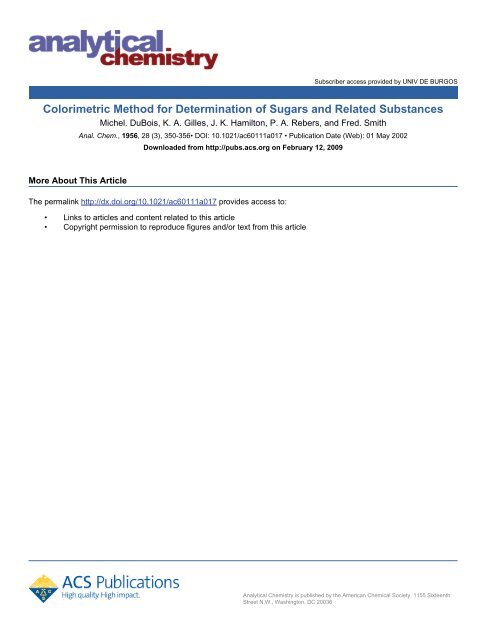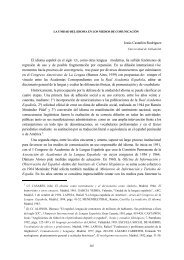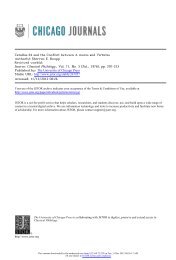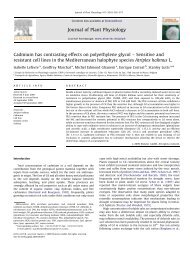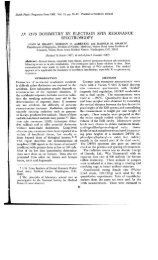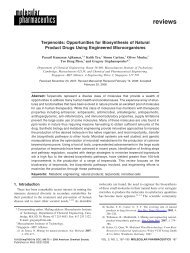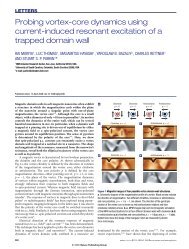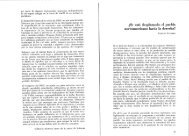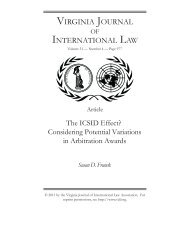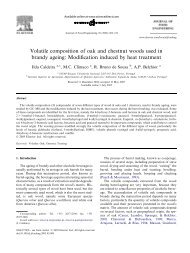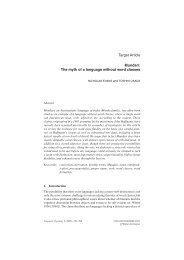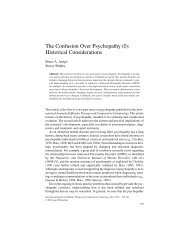Colorimetric Method for Determination of Sugars and Related ...
Colorimetric Method for Determination of Sugars and Related ...
Colorimetric Method for Determination of Sugars and Related ...
Create successful ePaper yourself
Turn your PDF publications into a flip-book with our unique Google optimized e-Paper software.
Subscriber access provided by UNIV DE BURGOS<br />
<strong>Colorimetric</strong> <strong>Method</strong> <strong>for</strong> <strong>Determination</strong> <strong>of</strong> <strong>Sugars</strong> <strong>and</strong> <strong>Related</strong> Substances<br />
Michel. DuBois, K. A. Gilles, J. K. Hamilton, P. A. Rebers, <strong>and</strong> Fred. Smith<br />
More About This Article<br />
Anal. Chem., 1956, 28 (3), 350-356• DOI: 10.1021/ac60111a017 • Publication Date (Web): 01 May 2002<br />
Downloaded from http://pubs.acs.org on February 12, 2009<br />
The permalink http://dx.doi.org/10.1021/ac60111a017 provides access to:<br />
• Links to articles <strong>and</strong> content related to this article<br />
• Copyright permission to reproduce figures <strong>and</strong>/or text from this article<br />
Analytical Chemistry is published by the American Chemical Society. 1155 Sixteenth<br />
Street N.W., Washington, DC 20036
<strong>Colorimetric</strong> <strong>Method</strong> <strong>for</strong> <strong>Determination</strong> <strong>of</strong> <strong>Sugars</strong><br />
<strong>and</strong> <strong>Related</strong> Substances<br />
MICHEL DUBOIS, K. A. GILLES, J. K. HAMILTON, P. A. REBERS, <strong>and</strong> FRED SMITH<br />
Division <strong>of</strong> Biochemistry, University <strong>of</strong> Minnesota, St. Paul, Minn.<br />
Simple sugars, oligosaccharides, polysaccharides, <strong>and</strong><br />
their derivatives, including the methyl ethers with free<br />
or potentially free reducing groups, give an orange-<br />
yellow color w-hen treated with phenol <strong>and</strong> concentrated<br />
sulfuric acid. The reaction is sensitive <strong>and</strong> the color<br />
is stable. By use <strong>of</strong> this phenol-sulfuric acid reaction,<br />
a method has been developed to determine submicro<br />
amounts <strong>of</strong> sugars <strong>and</strong> related substances. In conjunc-<br />
tion with paper partition chromatography the method<br />
is useful <strong>for</strong> the determination <strong>of</strong> the composition <strong>of</strong><br />
polysaccharides <strong>and</strong> their methyl derivatives.<br />
OLORIMETRIC tests <strong>for</strong> reducing sugars <strong>and</strong> polysaccharides<br />
have been known <strong>for</strong> a considerable time. The reagents<br />
such as 1-naphthol (33) <strong>for</strong> carbohydrates in general;<br />
benzidine <strong>for</strong> pentoses <strong>and</strong> uronic acids (27, 49, 50); naphthoresorcinol<br />
<strong>for</strong> uronic acids (61 ); <strong>and</strong> resorcinol (43), naphthoresorcinol<br />
(.%), <strong>and</strong> resorcinol disulfonic acid (31) <strong>for</strong> ketoses are<br />
well-knon-n examples <strong>of</strong> colorimetric tests that may be carried<br />
out in acid solution. Such tests as these <strong>and</strong> modifications <strong>of</strong><br />
them using aromatic amines <strong>and</strong> phenols (4, 22, 38) have recently<br />
gained added importance since the ext,ensive development,<br />
<strong>of</strong> partition chromat'ography <strong>for</strong> the separation <strong>and</strong> characterizat,ion<br />
<strong>of</strong> minute amounts <strong>of</strong> sugars <strong>and</strong> their derivatives (1, 4,<br />
8, 11, 12, 17, 18, 21-23, 26, S6, 39, 47). Polyols <strong>and</strong> carbohydrates<br />
with a reducing group may be detected by the Tollens<br />
silver reagent (39, 52), perhaps one <strong>of</strong> the best reagents in the<br />
art, <strong>of</strong> chromatography. Reducing sugars are also detectable<br />
by picric acid (7, l7), 3,4-dinitrobenzoic acid (5), 3,5-dinitrosalicylic<br />
acid (6, 32, 48), o-dinitrobenzene (17, 401, <strong>and</strong> methylene<br />
blue (54), Tvhile diazouracil is said to be specific <strong>for</strong> sucrose as<br />
well as oligosaccharides <strong>and</strong> polysaccharides containing the<br />
sucrose residue (42).<br />
Volunietric procedures involving the use <strong>of</strong> potassium ferricyanide<br />
(19), ceric sulfate (is), copper sulfate<br />
(16, 44), <strong>and</strong> sodium hypoiodite (20) are applicable<br />
to the determinat,ion <strong>of</strong> small amounts<br />
120<strong>of</strong><br />
reducing sugars after separation hy parti-<br />
their glycosides, it is <strong>of</strong> limited use <strong>for</strong> met,hylated sugars <strong>and</strong><br />
t.he pentoses. Although butanol-propionic acid-water is an excellent<br />
solvent <strong>for</strong> separating the disaccharides (4), the residual<br />
propionic acid interferes xith the 1-napht,holsulfonate method.<br />
Aniline phthalate (S8) <strong>and</strong> aniline trichloroacetate (17) have been<br />
utilized <strong>for</strong> the colorimetric determination <strong>of</strong> sugars <strong>and</strong> their<br />
derivatives (2, 3); these reagents, however, are unsatisfactory <strong>for</strong><br />
ketoses.<br />
Phenol in the presence <strong>of</strong> sulfuric acid can be used <strong>for</strong> the<br />
quantitative colorimetric microdetermination <strong>of</strong> sugars <strong>and</strong><br />
their methyl derivatives, oligosaccharides, <strong>and</strong> polysaccharides<br />
(15). This method is particularly useful <strong>for</strong> the determination <strong>of</strong><br />
small quantities <strong>of</strong> sugars separated by paper partibion chromatography<br />
with the phenol-wat,er solvent <strong>and</strong> also <strong>for</strong> those<br />
sugars separated with solvents vihich are volatile-e.g., but'anolethanol-water<br />
(39)) ethyl acetate-acetic acid-water (26), or<br />
methyl et,hyl ketone-lT-ater (4, 39). The method is simple,<br />
rapid, <strong>and</strong> sensitive, <strong>and</strong> gives reproducible results. The reagent<br />
is inexpensive <strong>and</strong> st,able, <strong>and</strong> a given solution requires only<br />
one st,<strong>and</strong>ard curve <strong>for</strong> each sugar. The color produced is<br />
permanent <strong>and</strong> it is unnecessary to pay special attention to the<br />
caontrol <strong>of</strong> the conditions.<br />
DETERMIhATION OF COYCENTR4TION OF PURE SCG4R<br />
SOLUTIOYS<br />
Reagents <strong>and</strong> Apparatus. Sulfuric acid, reagent grade 95.5%,<br />
con<strong>for</strong>ming to -4CS specifications, specific gravity 1.84.<br />
Phenol, 80% by weight, prepared by adding 20 grams <strong>of</strong> glass-<br />
distilled water to 80 giams <strong>of</strong> redistilled reagent grade phenol.<br />
This mixture <strong>for</strong>ms a v-ater-n-hite liquid that is readily pipetted.<br />
Certain preparations have been known to remain water-white<br />
after a years' storage, while others turn a pale yellow in 3 or 4<br />
months. The pale yellon- color that sometimes develops does not<br />
interfere in the determination, inasmuch as a blank is included.<br />
Coleman Junior, Evelyn, Klett-Summerson, or Beckman<br />
Model DU spectrophotometers. All \vere used with satisfactory<br />
results in this inwstigation.<br />
t,iori chromatography. However, experience 1.00- -<br />
show that t,hese methods require considerable<br />
skill <strong>and</strong> are time-consuming <strong>and</strong> sensit,ive<br />
to slight variation in the condit,ions.<br />
The anthrone (13, 14, 28, 3dJ 35, 53) <strong>and</strong><br />
the 1-naphtholsulfonat,e (10) reagents are excellent<br />
<strong>for</strong> st,<strong>and</strong>ard sugar solut,ions (3$)> but,<br />
when applied to the anal)-sis <strong>of</strong> sugars separated<br />
by partition chromatography, the presence<br />
<strong>of</strong> only traces <strong>of</strong> residual solvent drveloper<br />
may render them useless. 3Iost sugars<br />
can be separated on filter paper hy a phenol- O0 ' lb ' 210 ' 310 ' 40 ' 20 ' $0 ' '710 ' do ' 9'0 ' ,bo ' Ilb ' ,io<br />
s-ater solvent (,E?), but the!- cannot then be<br />
MICROGRAMS OF SUGAR<br />
determined by the anthrone reagent because<br />
Figure 1, St<strong>and</strong>ard curves<br />
residual phenol, held tenaciouslJ- in the paper,<br />
1. D-Xylose, Coleman Jr., 480 mp, 17 mg. interferes TT-ith the green color produced by the<br />
<strong>of</strong> phenol<br />
2. D-Mannose Beckman Model DU 490 mp 40 mg. <strong>of</strong> phenol<br />
anthrone reagent. Moreover, the anthrone 3. D-Mannose' Evelyn filter No. 496, 40 mg.'<strong>of</strong> phenol<br />
4. o-Galactose Coleman Jr 490 mp 33 mg. <strong>of</strong> phenol<br />
reagent is expensive <strong>and</strong> solutions <strong>of</strong> it in sul- 5, L-Arabinose', Coleman Jr:', 480 mp: 17 mg. <strong>of</strong> phenol<br />
6. o-Galacturonic acid, Coleman Jr., 485 ma. 17 mg. <strong>of</strong> phenol<br />
furir acid are not stable (30,34). The anthrone 7. L-Fucose Coleman Jr. 480 mp 40 mg. <strong>of</strong> phenol<br />
method also suffers from the disadvantage that,<br />
8. D-Glucurbne, Coleman'Jr., 485'nw 17 mg. <strong>of</strong> phenol<br />
9. 2 3.4,6-Tetra-o-methyl-~-glucose Coleman Jr 485 mp, 17 mg. <strong>of</strong> phenol<br />
while it is satisfactory <strong>for</strong> frw sugars <strong>and</strong><br />
10. ;-Glucose, Beckman Model DU,'4!?0 mp, 100 mg. <strong>of</strong> phenol<br />
350
VOLUME 28, NO. 3, MARCH 1956<br />
I20<br />
1.00<br />
.90 -<br />
.80<br />
.70 -<br />
.60<br />
w0 -<br />
m 4.50<br />
wm -<br />
4.40<br />
.30<br />
20<br />
.IO-<br />
I<br />
0 IO 20 30 40 50 60 70 80 90 100 110 I20<br />
MICROGRAMS OF SUGAR<br />
-<br />
-<br />
-<br />
-<br />
-<br />
-<br />
Figure 2. St<strong>and</strong>ard curves<br />
1.00 I , , , , , , ,<br />
01 ' ' I , , ,<br />
WAVE LENGTH-MILLIMICRONS<br />
Figure 3. -4bsorption curves<br />
Fast-delivery 5-ml pipet, to deliver 5 ml. <strong>of</strong> concentrated sul-<br />
furic acid in 10 to 20 seconds. This is easily prepared by cutting<br />
a portion <strong>of</strong> the tip <strong>of</strong> a st<strong>and</strong>ard 5-ml. pipet.<br />
Series <strong>of</strong> matched colorimetric tubes, internal diameter between<br />
16 <strong>and</strong> 20 mm. This diameter will allow good mixing without<br />
dissipating the heat too rapidly. A high maximum temperature<br />
is desired because it increases the sensitivity <strong>of</strong> the reagent.<br />
Series <strong>of</strong> micropipets delivering 0.02, 0.05, <strong>and</strong> 0.1 ml. The<br />
type described by Pregl (41) is satisfactory.<br />
Procedure. Two milliliters <strong>of</strong> sugar solution containing he-<br />
tween 10 <strong>and</strong> 70 y <strong>of</strong> sugar is pipetted into a colorimetric tube,<br />
<strong>and</strong> 0.05 ml. <strong>of</strong> 80% phenol (adjust amount according to Figures<br />
9 <strong>and</strong> 10) is added. Then 5 ml. <strong>of</strong> concentrated sulfuric acid is<br />
ttdded rapidly, the stream <strong>of</strong> acid being directed against the<br />
liquid surface rather than against the side <strong>of</strong> the test tube in<br />
/"<br />
351<br />
order to obtain good mixing. The tubes are<br />
allowed to st<strong>and</strong> 10 minutes, then they are<br />
shaken <strong>and</strong> placed <strong>for</strong> 10 to 20 minutes in a<br />
xvater bath at 25" to 30" C. be<strong>for</strong>e readings<br />
are taken. The color is stable <strong>for</strong> several hours<br />
<strong>and</strong> readings may be made later if necessary.<br />
The absorbance <strong>of</strong> the characteristic yellow-<br />
orange color is measured at 490 nip <strong>for</strong> hexoses<br />
<strong>and</strong> 480 nip <strong>for</strong> pentoses <strong>and</strong> uronic acids.<br />
Blanks are prepared by substituting distilled<br />
water <strong>for</strong> the sugar solution. The amount <strong>of</strong><br />
sugar may then be determined bj. reference to<br />
a st<strong>and</strong>ard curve previously constructed <strong>for</strong><br />
the particular sugar under esamination.<br />
All soliitions are prepared in triplicate to<br />
mininiizc errors resulting from accidental con-<br />
tamination \vith cellulose lint.<br />
If it is desired to avoid the use <strong>of</strong> niicaro-<br />
pipets, the phenol may be added as a 5% solu-<br />
tion in v;ater. The amounts <strong>of</strong> reactants are<br />
then: 1 or 2 nil. <strong>of</strong> sugar solution, 1 ml. <strong>of</strong><br />
5% phrnol in n-ater, <strong>and</strong> 5 ml. <strong>of</strong> concentrated<br />
sulfuric acid. -All other steps are the same as<br />
above.<br />
1. Sucrose, Beckman Model DV, 490 mr, 100 mg. <strong>of</strong> phenol<br />
2. Potatostarch, Beckman Model DU, 490 mp, 100 mg. <strong>of</strong> phenol<br />
:. Dextran from Leuconostoc mesenteroides strain NRRL 515<br />
Beckman Model DU. 490 mu. 103 mn. <strong>of</strong> Dhenol<br />
D-G~u~os~, Evelyn, filter No. 490, 80 mg<strong>of</strong> p'henol<br />
4: L-Rhamnose. Coleman Jr., 480 mfi, 40 mg. <strong>of</strong> phenol<br />
6. Raffinose, Beckman RIodel DE. 490 mp, 100 me. <strong>of</strong> phenol<br />
7. D-Fructose, Beckman Model Dr. 490 mp3 200 mg. <strong>of</strong> phenol<br />
8. 2-Deoxy-D-ribose, Coleman Jr., 490 mp, 80 mg. <strong>of</strong> phenol<br />
St<strong>and</strong>ard Curves. *A series <strong>of</strong> t)yic.al ,*tmdard<br />
curws is shown in Figures 1 <strong>and</strong> 2. In-<br />
.eluded in these figures are esamples <strong>of</strong> some<br />
<strong>of</strong> the sugars usually encountered in carbohydrate<br />
studiep-namely, pentose, deorypentow,<br />
mcthylpentose, aldohesoee, ketohesose, ht.wronic<br />
arid, disaccharide, trisaccharide, :nid<br />
certain methylated derivatives. In order to test t,he method,<br />
the experiments were repeated on different days <strong>and</strong> by different<br />
D-MANNOSE I80 q)<br />
operators. In all cases the variations between esperiment,s <strong>and</strong><br />
HYOROXYMETHYLFURFURAL<br />
between operators vere no more than 0.01 t,o 0.02 unit in allsorbance,<br />
which n-as t,he same order <strong>of</strong> magnitude as the vwiation<br />
between the triplicate samples.<br />
The experimental data <strong>for</strong> the various carbohydrates, esrept,<br />
2-deoxyribose, given in Figures 1 <strong>and</strong> 2 may be t,abulated by<br />
0-GALACTOSE (80 CI) calculating the value <strong>of</strong> a,, the absorbance index, in the equation<br />
9, = a,bc (Table I). The absorbance, A,, is a dimensionless<br />
Tao~ver, 6<br />
ratio equal to log,, __ where I' is per cent transmittance,<br />
Tsolutiou'<br />
b is the length <strong>of</strong> light. pat'h, expressed in centimeters, <strong>and</strong> c is<br />
the concentration, in micrograms <strong>of</strong> sugar per milliliter <strong>of</strong> final<br />
volume.<br />
Discussion <strong>of</strong> Results. ABSORPTIOS CCRVES. The rurves<br />
obtained by plotting ahsorixinw t3.s. wave length (Beckman >lode1<br />
D-XYLOSE (80 71<br />
WAVE LE~~~TH-MILLIMICKONS<br />
Figure 4. -4bsorption curves<br />
9 0.1 ml. <strong>of</strong> butanol-ethanol-water chromatographic developing solvent<br />
(4 to 1 to 5, upper layer) was added in addition to the phenol
352 ANALYTICAL CHEMISTRY<br />
JILT) are 9hon.n in Figures 3 to 8; the absorption curve is charac-<br />
teristic <strong>for</strong> each <strong>of</strong> t'he sugars described (9, 26). The pentoses,<br />
methylpentoses, <strong>and</strong> uronic acids have an absorption maximum<br />
at 4S0 mp, while hexoses <strong>and</strong> their met'hylated derivatives have<br />
an absorption maximum at 485 to 490 mp. Certain <strong>of</strong> the met,h-<br />
ylat,ed pentose sugars <strong>and</strong> their methyl glycosides show select,ive<br />
absorption at about 415 to 420 mp (Figure 8) <strong>and</strong> <strong>for</strong> this reason<br />
the colorimetric det,erminat,ion <strong>of</strong> 2:3,5-tri-o-methjd-~-arabinose<br />
<strong>and</strong> its methyl glycoside is best carried out, at 415 m p,<br />
The D-xylose <strong>and</strong> furfural curves are very similar. Assuming<br />
t,hat the amount <strong>of</strong> color is proportional to the amount <strong>of</strong> fur-<br />
furnl present or produced, the conversion <strong>of</strong> D-xylose to furfural<br />
under t,he conditions <strong>of</strong> the test is 93% <strong>of</strong> theory.<br />
Calculation <strong>of</strong> conversion oi o-xylose to furfural<br />
hf.\T. Micrograms Absorbanpe<br />
1:urf iiral 96 39 40 1.25<br />
D-Xylore 150 80 1.50<br />
The percentage, P, <strong>of</strong> xylose converted to furfural in the reac-<br />
t,ion as measured by the intensity <strong>of</strong> color developed can he<br />
calculated as illustrat.ed belon-:<br />
D-Friic tose<br />
Sucrose<br />
:I<br />
1.201<br />
g 1.00<br />
.80<br />
\FFINOSE 180 1 1<br />
D-FRUCTOSE I80<br />
SUCROSE (80 71<br />
0<br />
400 IO 20 30 40 50 eo To Bo<br />
1<br />
So 500 io 20 30 60 50 So 70<br />
J<br />
80<br />
WAVE LENGTH-MlLLlUlCROYS<br />
Figure 5. 4hsorption curves<br />
Table I. Absorption Data <strong>for</strong> Certain Carbohydrates Determined by Phenol-Sulfuric .Acid Reagent<br />
Compound<br />
5-Hydroxyinethyl-2-furaldehyde<br />
Starch<br />
Dextran<br />
D-Galacturonic acid<br />
D-Mannurone<br />
D-Glucurone<br />
D-Galactose<br />
D-Mannose<br />
~-.\rabinose<br />
D-Xylose<br />
L-Rhamnose<br />
L-Fucose<br />
RI a1 t os e<br />
Raffinose<br />
Lactose<br />
2-o-RIetliyl-~-xslose<br />
2 3-Di-o-methyl-D-xylose<br />
hiethyl 2,3-di-o-methyl-~-xyloside<br />
Jlrtliyl 2,3-di-o-methyl-D-xyloside<br />
2 3 3-Tri-o-methyl-L-arabinose<br />
Ripthy1 2,3,5-tri-o-methyl-~-arabinoside<br />
2.3-Di-o-methyl-~-glucose<br />
2,3,R-Tri-o-niethyl-D-glucose<br />
2,3,4 6-Tetra-o-methyl-D-glucose<br />
? 3-Di-o-methvl-D-mannose<br />
2:3,0-Tri-o-n~eiliyl-D-mannose<br />
2,3.4.G-Tetra-o-methyl-~-galactose<br />
Wt.,<br />
Y<br />
37 1<br />
42.4<br />
42.4<br />
42.4<br />
42 4<br />
42.4<br />
42.2<br />
42.2<br />
42.2<br />
80<br />
53.6<br />
26.3<br />
33<br />
40<br />
40<br />
40<br />
62.4<br />
124.8<br />
187.2<br />
312.0<br />
62,1<br />
124.8<br />
34 36<br />
68 72<br />
137.44<br />
286. 4<br />
34.36<br />
68.72<br />
80<br />
80<br />
80<br />
80.2<br />
80<br />
80<br />
80<br />
80<br />
80<br />
40<br />
50<br />
R 0<br />
50<br />
58.5<br />
47.7<br />
47.7<br />
40<br />
50<br />
s!:<br />
80<br />
50<br />
50<br />
50<br />
Plienil.<br />
Mg. c<br />
40<br />
51.6<br />
103<br />
154<br />
206<br />
310<br />
61.6<br />
103<br />
15%<br />
40<br />
40<br />
40<br />
100<br />
154<br />
206<br />
257<br />
10.3<br />
103<br />
103<br />
10.3<br />
103<br />
103<br />
10.3<br />
103<br />
103<br />
103<br />
103<br />
103<br />
10<br />
40<br />
40<br />
40<br />
40<br />
40<br />
40<br />
10<br />
16<br />
100<br />
100<br />
100<br />
20<br />
20<br />
33<br />
35<br />
50<br />
50<br />
40<br />
40<br />
120<br />
50<br />
50<br />
50<br />
rol,,<br />
MI.<br />
6.60<br />
6.01<br />
6.64<br />
6.68<br />
6.72<br />
G.80<br />
6.61<br />
6.64<br />
6.68<br />
6.60<br />
6.60<br />
6 60<br />
6.64<br />
6.68<br />
6.72<br />
6.76<br />
6.G4<br />
6.64<br />
6.64<br />
6.64<br />
0.64<br />
6 64<br />
6 64<br />
0 6%<br />
6 64<br />
R.li1<br />
6.64<br />
6.64<br />
6.58<br />
0.60<br />
6.60<br />
G.60<br />
6.60<br />
6.60<br />
6 60<br />
6.38<br />
6.58<br />
6.63<br />
6.63<br />
6.03<br />
7.45<br />
7.13<br />
7.45<br />
7.4.5<br />
7.43<br />
7.4,;<br />
0.60<br />
6.60<br />
6.65<br />
6.57<br />
6.57<br />
6.37<br />
H, Beckman Model DU; C, Coleman Junior: K, Klett-Summerson.<br />
1000 X absorbance<br />
b Iilett reading =<br />
2<br />
c Artd xeight <strong>of</strong> phenol. To find weight <strong>of</strong> 80% solution, divide by 0.8.<br />
Light<br />
Path<br />
Cn1.<br />
1<br />
1<br />
1<br />
1<br />
1<br />
1<br />
1<br />
1<br />
1<br />
1<br />
1<br />
1<br />
1.6<br />
1<br />
1<br />
1<br />
1.27<br />
1.27<br />
1.27<br />
l.?i<br />
1<br />
1<br />
1 27<br />
1.27<br />
1.27<br />
1. ?7<br />
1<br />
1<br />
1 .no<br />
1.00<br />
1.00<br />
1.00<br />
1.00<br />
1.00<br />
1.00<br />
1.00<br />
1.00<br />
1.6<br />
1.6<br />
1.6<br />
1 . li<br />
1.6<br />
1.00<br />
1.00<br />
1.6<br />
1.6<br />
1.00<br />
1.00<br />
1.00<br />
1.6<br />
1 .6<br />
1.0<br />
1n.t rii.<br />
meut<br />
B<br />
H<br />
F\<br />
B<br />
R<br />
B<br />
R<br />
B<br />
B<br />
B<br />
B<br />
B<br />
C<br />
R<br />
B<br />
B<br />
I<<br />
Ii<br />
K<br />
Ii<br />
B<br />
n<br />
Ii<br />
Ii<br />
K<br />
B<br />
B<br />
B<br />
R<br />
B<br />
H<br />
B<br />
B<br />
R<br />
H<br />
B<br />
c<br />
c<br />
C<br />
C<br />
c<br />
B<br />
B<br />
C<br />
C<br />
B<br />
B<br />
C<br />
c<br />
C<br />
Ware<br />
Lingth,<br />
@<br />
490<br />
490<br />
490<br />
490<br />
490<br />
490<br />
485<br />
485<br />
483<br />
487<br />
490<br />
490<br />
490<br />
490<br />
490<br />
490<br />
Blue, So. 42<br />
Blue, No. 42<br />
Blue, No. 42<br />
Blue. No. 43<br />
488<br />
488<br />
Blue, No. 42<br />
Blue, h-0, 42<br />
Blue, No. 42<br />
Blue, pio. 42<br />
488<br />
488<br />
480<br />
485<br />
480<br />
487<br />
487<br />
480<br />
480<br />
480<br />
480<br />
490<br />
490<br />
440<br />
483<br />
480<br />
480<br />
415<br />
415<br />
415<br />
485<br />
485<br />
485<br />
485<br />
48.7<br />
485<br />
Ibs?rh-<br />
ance<br />
0.31<br />
0 . 3 3<br />
0.48<br />
0.52<br />
0.47<br />
0.58<br />
0.45<br />
0.445<br />
0.40<br />
0.78<br />
0.45<br />
0. 237<br />
0.395<br />
0.86<br />
0.93<br />
0.98<br />
0,0328<br />
O.OG4<br />
0.096<br />
0.146<br />
0.73<br />
1.43<br />
0.0160<br />
0.0338<br />
0 0646<br />
0 1350<br />
0.40<br />
0.81<br />
0.532<br />
0.39<br />
0,287<br />
0.604<br />
1.01<br />
0.90<br />
1.50<br />
0.81'<br />
0.33<br />
0.47<br />
0.40<br />
0.355<br />
0.31<br />
0.39<br />
0.23<br />
0.21<br />
0.27<br />
0.325<br />
; ;;3<br />
0.57<br />
0.39<br />
0.37<br />
0 37<br />
~~.<br />
as<br />
0.0347<br />
0,0545<br />
0.073'2<br />
0.0819<br />
0,0902<br />
0.0928<br />
0.0704<br />
0.0702<br />
0.0632<br />
0.0640<br />
0 0591<br />
0.0594<br />
0.0468<br />
0.143<br />
0.159<br />
0.160<br />
0.00275<br />
0 002iiS<br />
0.00268<br />
0.00236<br />
0.0799<br />
0,0772<br />
0,00252<br />
0.00257<br />
0.00240<br />
0.00232<br />
0.0774<br />
0.0784<br />
0.0439<br />
0.0322<br />
0.0237<br />
0,0340<br />
0,0835<br />
0 0742<br />
0.1239<br />
0,0074<br />
0.0288<br />
0.0492<br />
0.0381<br />
0,0294<br />
0,0289<br />
0.031<br />
0.036<br />
0.0328<br />
0.0311<br />
0.0302<br />
0,0708<br />
0,0690<br />
0.0474<br />
0.0320<br />
0.0304<br />
0.0301
VOLUME 28, NO. 3, MARCH 1956<br />
Calculation <strong>of</strong> final volume<br />
2 ml. water 2<br />
5 ml. sulfuric acid X 1.84 9.20<br />
Total wt. 11.20 grams<br />
Concn. <strong>of</strong> sulfuric acid after mixing<br />
Density <strong>of</strong> 78% sulfuric acid (20° C.)<br />
11.20<br />
Volume <strong>of</strong> mixture ~ = 6.57 ml.<br />
1.70<br />
9'20<br />
11.20 = 78%<br />
1.7043<br />
The addition <strong>of</strong> small amounts <strong>of</strong> phenol was considered to have a<br />
negligible effect on the density <strong>of</strong> the solution; hence, 0 1 ml. <strong>of</strong> 80%<br />
phenol would increase the volume by 0.OG ml.<br />
2 nil. water 2<br />
1 ml. 5% phenol in water 1<br />
5 ml. sulfuric acid __ 9 2<br />
Total wt. 12.2 grams<br />
400 10 20 30 40 10 so 70 80 90 500 10 20 30 40 50 SO 70 80<br />
90 - -<br />
WAVE LENGTH-MILLIMICRONS<br />
Figure 6. Absorption curves<br />
2,3-DI-O-METHYL-D-GLUCOSE 180 7 I -<br />
430 io 20 30 40 10 so 70 80 90 500 IO 20 30 40 50 60 70 80<br />
WAVE LENGTH-MILLIMICRONS<br />
Figure 7. Absorption curves<br />
353<br />
Table 11. Relationship between Index <strong>of</strong> Absorbance <strong>and</strong><br />
Sugar Concentration as Determined by Different<br />
Instruments<br />
Approx. D- Light<br />
B<strong>and</strong> Width, Mannose, Path Absorb-<br />
Instrument MM Y ~m.' ance as<br />
Beckman 0.5 80 1.00 1.01 0.0835<br />
Model DU 0.5 40 1.00 0.495 0.0815<br />
0.5 20 1.00 0.25 0.0826<br />
Coleman Jr. 50 41.1 1.6 0.45 0.0451<br />
50 20.5 1.6 0.24 0,0481<br />
50 10.2 1.6 0.11 0.0442<br />
Evelyn 65 40 1.9 0.49 0.0426<br />
65 20 1.9 0.27 0.8464<br />
65 10 1.9 0.13 0.0473<br />
Concn. <strong>of</strong> sulfuric acid 9'20 0'95 = 71.6%<br />
12.2<br />
Density at 20' C. 1,628<br />
12 20<br />
Volume <strong>of</strong> mixture __ = 7 48 ml.<br />
1 628<br />
EFFECT OF VARIABLE AivousTs OF PHEYOL. The intensity<br />
<strong>of</strong> the color is a function <strong>of</strong> the amount <strong>of</strong> phenol added. As<br />
the amount <strong>of</strong> phenol is increased, the absorbance increases to<br />
a maximum <strong>and</strong> then usually falls <strong>of</strong>f (Figures 9 <strong>and</strong> IO). When a<br />
paper chromatographic separation has been effected using phenol<br />
as a solvent, it \?-ill be found impractical to remove all <strong>of</strong> the phenol<br />
developer by air drying. This is not essential, though,<br />
because the curve <strong>of</strong> absorbance ts. amount <strong>of</strong> phenol is relatively<br />
flat after the maximum color intensity has been reached. Reproducible<br />
results can be obtained by operating at either side <strong>of</strong><br />
the peak or at the peak as long as the amount <strong>of</strong> phenol added<br />
is controlled This could conceivably <strong>for</strong>m the basis <strong>for</strong> the<br />
analysis <strong>of</strong> mixtures <strong>of</strong> sugars-<strong>for</strong> instance, <strong>of</strong> D-mannose <strong>and</strong><br />
n-glucose-by making txo series <strong>of</strong> experiments, one at lox <strong>and</strong><br />
one at high phenol concentrations. The difference in readings<br />
is not large enough by itself except <strong>for</strong> rather crude estimations]<br />
but in combination with the variation in IT ave length <strong>of</strong> absorption<br />
maxima peaks between pentoses or uronic acids <strong>and</strong> hexoses,<br />
a satisfactory analysis might be devised.<br />
A procedure using a somewhat similar idea, the rate <strong>of</strong> color<br />
development betn een sugars <strong>and</strong> the anthrone reagent, has been<br />
reported by Koehler (28).<br />
C<br />
a<br />
.50 , I " '<br />
2,3-Dl-O-METHYL-D-XYLOSE 56 5 7 )<br />
-L T\. < 2.3.5-TRI-0-METHYL-L-ARABINOSE 146.6 7)<br />
METHYL<br />
D-XYLOSIDE (477 7)<br />
METHYL 2,3,5-TRl-O-METHYL-<br />
L-ARABINOSIDE (37.8 71<br />
0 ' " " ' 1 ' "<br />
400 10 20 30 40 50 so 70 80 90 500 to 20 30 eo 50 60 70 80<br />
WAVE LENGTH-MILLIMICRONS<br />
Figure 8. Absorption curves<br />
EFFECT<br />
OF BASD WIDTH. The absorbance, as is generally<br />
true in colorimetric determinations, is a function <strong>of</strong> the length <strong>of</strong><br />
light path as well as the b<strong>and</strong> width <strong>of</strong> the light source. As the<br />
b<strong>and</strong> width becomes narrower, the observed absorbance becomes<br />
greater. If the values <strong>of</strong> the constant a, are calculated from the<br />
equation A, = a,bc, the effect <strong>of</strong> the b<strong>and</strong> v-idth becomes ap-<br />
parent (Table 11).
354 ANALYTICAL CHEMISTRY<br />
The higher the value <strong>of</strong> a,, the more sensitive is the instrument.<br />
On this basis, the Beckman was the most sensitive instrument<br />
used; the others, however, per<strong>for</strong>m well enough <strong>for</strong> routine<br />
analysis.<br />
In the case <strong>of</strong> the Evelyn <strong>and</strong> the Coleman colorimeters, the<br />
value <strong>of</strong> a, is not constant. This means that the plot <strong>of</strong> con-<br />
centration us. absorbance is not linear at the higher concen-<br />
trations; however, it is very nearly linear at lower concen-<br />
trations. The linearity <strong>of</strong> the plot <strong>of</strong> absorbance us. concentra-<br />
tion is extended to higher regions <strong>of</strong> concentration by operating<br />
at narrower b<strong>and</strong> widths. The points obtained in the nonlinear<br />
region with the colorimeters passing wider b<strong>and</strong>s are, neverthe-<br />
less, reproducible (Table 11).<br />
ACCURACY OF hlETHOD. Under the proper conditions, the<br />
method can be expected to be accurate to within 2~2%. This<br />
figure was obtained by plotting the results obtained by use <strong>of</strong><br />
the Beckman hlodel DU spectrophotometer <strong>and</strong> comparing<br />
the amount <strong>of</strong> sugar actually present with that indicated by the<br />
plot. As mentioned previously, the narrow b<strong>and</strong> width <strong>of</strong> the<br />
Beckman spectrophotometer makes it possible to extend the<br />
linearity <strong>of</strong> the st<strong>and</strong>ard curve. The percentage error is shom-n<br />
in Table 111.<br />
Table 111. Accuracy <strong>of</strong> Phenol-Sulfuric .4cid Rlethod <strong>for</strong><br />
Sugar <strong>Determination</strong><br />
Compound<br />
Taken,<br />
Y<br />
Found,<br />
Y<br />
Error,<br />
% Absorbance<br />
Mannose<br />
Galactose<br />
80<br />
40<br />
20<br />
80.4<br />
40.2<br />
21.4<br />
81<br />
39<br />
20<br />
i9.5<br />
39.5<br />
21.5<br />
1.3<br />
2.5<br />
0.0<br />
1.1<br />
1.7<br />
0.5<br />
1.01<br />
0.495<br />
0.25<br />
0.665<br />
0.326<br />
0.175<br />
Conclusions. The phenol-sulfuric acid method can be used to<br />
give reliable estimations <strong>of</strong> the sugar content <strong>of</strong> pure solutions.<br />
The colors produced are unusually stable, <strong>and</strong> possess a definite<br />
absorption peak. The amount <strong>of</strong> color produced at a constant<br />
phenol concentration is proportional to the amount <strong>of</strong> sugar<br />
present. The st<strong>and</strong>ard curves obtained by plotting the sugar<br />
concentration us. the absorbance can be readily reproduced <strong>and</strong>,<br />
because <strong>of</strong> this, only one st<strong>and</strong>ard curve need be prepared <strong>for</strong> a<br />
given sugar. Furthermore, the reagents are inexpensive, stable,<br />
<strong>and</strong> readily available.<br />
QUANTITATIVE ANALYSIS OF SUGARS BY PAPER<br />
CHROMATOGRAPHY<br />
The application <strong>of</strong> qualitative paper chromatography to the<br />
separation <strong>of</strong> sugar mixtures has been extended to the field <strong>of</strong><br />
quantitative analysis. Any sugars that can be separated by<br />
the technique <strong>of</strong> paper chromatography can be determined<br />
quantitatively by the colorimetric technique just described after<br />
elution from the paper (IS, 15, 29). The principle is simple,<br />
but certain factors complicate the analysis. Probably the most<br />
serious <strong>of</strong> these is that carbohydrate impurities are extracted<br />
from the paper along with the sugar to be analyzed. This<br />
source <strong>of</strong> error is reduced greatly by the simple expedient <strong>of</strong><br />
running a blank. The size <strong>of</strong> the blank reading may be reduced<br />
to about one half by washing the papers with distilled water<br />
containing about 1 % ammonia (37). Another complicating<br />
factor is the introduction <strong>of</strong> cellulose lint during the elution pro-<br />
cedure, but this can be eliminated entirely by careful filtration.<br />
A procedure similar to the one described herein is reported by<br />
Dimler <strong>and</strong> others (13). However, their elution procedure is<br />
considerably more complicated than the one used in this<br />
work. Furthermore, the best colorimetric technique at the dis-<br />
posal <strong>of</strong> these workers was the anthrone method, the disadvan-<br />
tages <strong>of</strong> which have already been explained.<br />
Washing <strong>of</strong> Paper. The following experiment illustrates how<br />
the soluble carbohydrate fraction present in filter paper may be<br />
reduced by washing. This fraction cannot be entirely washed<br />
out (24), <strong>and</strong> seems to increase after the washed paper is allowed<br />
to dry (46). Other work (24) in this laboratory has shown that<br />
the soluble carbohydrate fraction <strong>of</strong> filter paper is <strong>of</strong> the nature<br />
<strong>of</strong> a pentosan. The further study <strong>of</strong> this carbohydrate material<br />
will <strong>for</strong>m the subject <strong>of</strong> another communication.<br />
MILLIGRAMS OF PHENOL<br />
Figure 9. Absorbance us. amount <strong>of</strong> phenol<br />
1. D-Xylose, 40 y, Coleman Jr.. 480 m#<br />
2. D-Mannose 41 y Evelyn filter No. 490<br />
3. D-Glucose, i Z y, Beokrnad Model DU, 485 mp<br />
4. 2-Deoxv-~-ribose. 49 Y. Coleman Jr.. 490 mu<br />
5.<br />
6.<br />
7.<br />
D-Galaitose, 54 y, Coleman Jr., 490 mp<br />
L-Rhamnose, 52 y Evelyn filter No. 490<br />
L-Fucose. 25 y. Cdleman Ji., 480 m p<br />
A piece <strong>of</strong> Whatman No. 1 filter paper 22 X 4 inches was<br />
washed with distilled water containing 0.5% ammonia <strong>and</strong> dried<br />
<strong>for</strong> 24 hours. The pa er was added to a beaker containing 20 ml.<br />
<strong>of</strong> distilled water anf allowed to st<strong>and</strong> with occasional shaking<br />
<strong>for</strong> 20 minutes. The solution was filtered through a plug <strong>of</strong> glass<br />
wool <strong>and</strong> a 2-mi. aliquot <strong>of</strong> it was transferred to a colorimeter<br />
tube. Forty milligrams <strong>of</strong> phenol was added as an 80% solution<br />
<strong>of</strong> phenol in water <strong>and</strong> then 5 ml. <strong>of</strong> concentrated sulfuric acid.<br />
The absorbance <strong>of</strong> the solution was determined with an Evelyn<br />
colorimeter.<br />
The solutions from the washed <strong>and</strong> unwashed papers showed<br />
absorbances <strong>of</strong> 0.03 <strong>and</strong> 0.06, respectively.<br />
Procedure. Two sheets <strong>of</strong> Whatman So. 1 filter paper 8 X 22<br />
inches are prepared as described below. One <strong>of</strong> the sheets is<br />
used as a blank. Be<strong>for</strong>e placing any sugars on the paper, lines<br />
are drawn as follows: Two lines are drawn lengthwise 1.5 inches<br />
from the edge <strong>of</strong> the paper. Two more lines are drawn, the first<br />
1 inch from the top <strong>and</strong> the second 3.5 inches from the top. The<br />
sugars to be analyzed are placed on the paper along the 3.5-inch<br />
line. The two strips 1.5 inches from the edge are marking strips,<br />
which will be cut <strong>of</strong>f <strong>and</strong> sprayed with p-anisidine or p-phenetidine<br />
trichloroacetate or ammoniacal silver nitrate after development<br />
<strong>of</strong> the chromatogram. The appearance <strong>of</strong> the spots marks the<br />
distance the sugars have traveled in the marking strips <strong>and</strong> the<br />
unsprayed center section. The amount <strong>of</strong> sugar added to the<br />
marking strip is not critical as long as enough is present to give<br />
a s ot xith the spray reagent. However, the amount <strong>of</strong> sugars<br />
adfed to the 5-inch center section <strong>of</strong> the paper must be accurately<br />
measured if it is desired to determine the absolute amounts <strong>of</strong><br />
sugars as well as the relative amounts in the mixture.<br />
A margin <strong>of</strong> at least 0.5 inch should be allowed, leaving 4<br />
inches in the center to which a measured amount <strong>of</strong> sugar solution<br />
can be added from a micropipet.<br />
The amount <strong>of</strong> sugar which can be added be<strong>for</strong>e overlapping <strong>of</strong><br />
the spots occurs should be determined <strong>for</strong> each type <strong>of</strong> analysis.<br />
This can be done by putting graded amounts <strong>of</strong> sugar on several<br />
papers, drying, then developing with solvent, drying, <strong>and</strong> then<br />
spraying the entire paper. This will show whether the sugars
VOLUME 28, NO. 3, MARCH 1956<br />
move in discrete b<strong>and</strong>s, <strong>and</strong> how much margin should be allowed<br />
along the edges. The larger the amount <strong>of</strong> sugars which can be<br />
added, the less significance the blank will have. In most cases<br />
about 600 to 1000 y <strong>of</strong> sugar should be added. Dimler <strong>and</strong> others<br />
(IS) recommend that another paper be prepared to counteract<br />
the variations in delivery that may occur with micropipets. To<br />
this paper they add st<strong>and</strong>ard amounts <strong>of</strong> known sugars, using<br />
the same pipet <strong>and</strong> the same technique. This procedure does<br />
not, <strong>of</strong> course, eliminate the need <strong>for</strong> a blank determination,<br />
because the presence <strong>of</strong> the soluble carbohydrate fraction in the<br />
filter paper will have a relatively greater effect at low sugar con-<br />
centrations. After the sugars have been added to the paper, the<br />
chromatograms are developed <strong>for</strong> a long enough period so that<br />
the sugars to be analyzed are clearly separated. After the<br />
chromatogram has been dried in the air, the side marking strips<br />
are cut <strong>of</strong>f <strong>and</strong> sprayed to show the location <strong>of</strong> the sugars in the<br />
center section. The center unsprayed portion <strong>of</strong> the chromato-<br />
gram is then cut up into sections corresponding to the locations <strong>of</strong><br />
the sugar. Each section is transferred to Petri dishes, beakers, or<br />
other suitable containers that can be covered or closed. The<br />
blank paper is cut up to correspond to the area <strong>and</strong> location <strong>of</strong><br />
the sugars <strong>of</strong> the other paper. Twenty milliliters <strong>of</strong> distilled<br />
water is added to each <strong>of</strong> the Petri dishes, which are then covered<br />
<strong>and</strong> allowed to st<strong>and</strong> <strong>for</strong> 30 minutes with occasional shaking.<br />
During this time the sugar becomes equally distributed through-<br />
out the liquid <strong>and</strong> solid phases (water <strong>and</strong> cellulose). The eluate<br />
is filtered through glass wool <strong>and</strong> the concentration <strong>of</strong> sugars<br />
determined as described be<strong>for</strong>e, with the important difference<br />
that the absorbance <strong>of</strong> the blank reading is subtracted from that<br />
corresponding to the sugar be<strong>for</strong>e referring to the st<strong>and</strong>ard curve.<br />
Results. EFFICIEXCY OF EXTRACTIO% OF SUGARS FROM FILTER<br />
PAPER. This is illustrated by two typical euperiments:<br />
1. With a micropipet, 0.102 ml. <strong>of</strong> a solution containing 4.52<br />
mg. <strong>of</strong> D-fructose was added to a piece <strong>of</strong> Whatman No. 1 paper<br />
(3 X 5 inches). The paper was allowed to dry in the air <strong>for</strong> 24<br />
hours <strong>and</strong> then soaked in 20 ml. <strong>of</strong> distilled water <strong>for</strong> 0.5 hour to<br />
extract the sugar. (In another series <strong>of</strong> experiments it was found<br />
2'oOl I .80<br />
Wl.2Ot- / /<br />
Y<br />
tf /<br />
' ' '<br />
.20y<br />
'! ' 40 80 120 160 26, ' 2iO<br />
I I<br />
MILLIGRAMS OF PHENOL<br />
280 ' 3;C<br />
Figure 10. Absorbance us. amount <strong>of</strong> phenol<br />
1. D-Fructose. 80 Y. Beckman ?.lode1 DU. 490 mu<br />
DU, 485 mr<br />
490<br />
355<br />
that sugars are extracted from the paper almost immediately.)<br />
The extract was filtered through glass wool <strong>and</strong> a 2-ml. aliquot<br />
<strong>of</strong> the filtrate added to 20 ml. <strong>of</strong> water. Two milliliters <strong>of</strong> this<br />
diluted solution was treated with 258.4 pl. <strong>of</strong> 80% aqueous phenol,<br />
followed by 5 ml. <strong>of</strong> concentrated sulfuric acid. The observed<br />
absorbance at 490 mp was 0.548 <strong>and</strong> 0.538.<br />
In a blank experiment a piece <strong>of</strong> paper <strong>of</strong> identical size was<br />
extracted <strong>for</strong> 0.5 hour with 20 ml. <strong>of</strong> water. A 2-ml. aliquot was<br />
treated with phenol <strong>and</strong> sulfuric acid as described above. The<br />
absorbance was 0.10 (average <strong>of</strong> three results). Hence, the ab-<br />
2<br />
sorhance correction <strong>for</strong> the blank = 0.10 X - = 0.01.<br />
22<br />
Corrected absorbance <strong>for</strong> the sugar determination = 0.54 -<br />
0.01 = 0.53. From the st<strong>and</strong>ard curve <strong>for</strong> fructose, an absorb-<br />
ance <strong>of</strong> 0.57 is equivalent to 42.4 y <strong>of</strong> sugar. There<strong>for</strong>e, the<br />
0.53<br />
amount <strong>of</strong> fructose equivalent to an absorbance <strong>of</strong> 0.53 = __<br />
0.57<br />
0 53<br />
X 42.4 y. Hence the total fructose recovered = X 42.4<br />
0.57<br />
20 22<br />
X - X - = 4336 y.<br />
2 2<br />
4336<br />
Recovery = T X 100 = 96%.<br />
4020<br />
2. A similar experiment carried out with D-glucose (400 y)<br />
added to a piece <strong>of</strong> paper (2 X 2 inches) gave a recovery <strong>of</strong> 100%.<br />
Additional experiments with D-mannose, D-xylose, <strong>and</strong> L-arabi-<br />
nose, <strong>and</strong> xith methylated sugars such as 2,3,4,6-tetra-o-methyl-,<br />
2,3,6-tri-o-methyl-, <strong>and</strong> 2,3-di-o-methy1-~-glucose with <strong>and</strong><br />
without solvent migration using phenol-water, butanol-ethanol-<br />
water, <strong>and</strong> methyl ethyl ketone-water azeotrope gave recoveries<br />
<strong>of</strong> 95 to 100%.<br />
ANALYSIS OF A SYXTHETIC MIXTURE OF SUGARS. (1) A solution<br />
containing D-fructose (3.18 mg.) <strong>and</strong> D-glucose (0.20 mg.)<br />
was transferred to a piece <strong>of</strong> Whatman No. 1 paper (8 X 22<br />
inches) as described previously. The chromatogram was developed<br />
<strong>for</strong> 24 hours by use <strong>of</strong> phenol saturated with water as the<br />
solvent. The paper was removed from the chromatographic<br />
chamber <strong>and</strong> allon-ed to dry <strong>for</strong> 24 hours. The marginal strips<br />
were cut <strong>of</strong>f <strong>and</strong> sprayed with p-anisidine trichloroacetic acid<br />
reagent (small amounts <strong>of</strong> phenol do not interfere). After reassembling<br />
the chromatogram, the best line <strong>of</strong> demarcation was<br />
drawn between the two spots <strong>and</strong> the sections were cut out (glucose,<br />
6 to 8.5 inches, fructose, 8.5 to 11 inches from the starting<br />
line), together with the corresponding blanks as previously described.<br />
The pieces <strong>of</strong> paper containing the two sugars <strong>and</strong> the<br />
tn-o blanks were extracted <strong>and</strong> filtered. The concentration <strong>of</strong><br />
the two sugars vias then determined by the phenol-sulfuric acid<br />
reagent, reference being made to st<strong>and</strong>ard curves <strong>for</strong> glucose <strong>and</strong><br />
fructose. The results mere as follows:<br />
Glucose Recovery<br />
Absorbance <strong>of</strong> the eluate (2 ml. out <strong>of</strong> 20 ml. removed <strong>for</strong><br />
test) 0.32<br />
;ibsorbance <strong>of</strong> blank 0 10<br />
;Ibsorbance <strong>for</strong> glucose 0 22<br />
From the st<strong>and</strong>ard curve <strong>for</strong> glucose absorbance, 0.45 = 42.4 y glucose<br />
0 22<br />
Absorbance <strong>of</strong> 0.22 = ~ X 42 4 y glucose<br />
0 45<br />
0 22 20<br />
Total glucose recovered = __ X 42 4 X - = 206 y glucose<br />
0 45 2<br />
Recovery = 103%.<br />
Fructose Recovery<br />
dbsorbance <strong>of</strong> eluate (diluted 2 ml. to 20 ml. <strong>of</strong> water) 0 40<br />
Absorbance <strong>of</strong> blank 0 01<br />
Absorbance <strong>for</strong> fructose 0.39<br />
From the st<strong>and</strong>ard curve <strong>for</strong> fructose absorbance, 0.57 = 42.4 y fruc-<br />
tose<br />
0.39<br />
Absorbance <strong>of</strong> 0.39 = 7 X 42 4 y fructose<br />
0.07
356 ANALYTICAL CHEMISTRY<br />
0 39 20 22<br />
Total fructose recovered = e X 42.4 X - X - = 3200 y fructose<br />
0.07 2 2<br />
Recovery = 10170.<br />
Conclusions. The phenol-sulfuric acid method can be applied<br />
to the analysis <strong>of</strong> any mixtures <strong>of</strong> sugars <strong>and</strong> their methyl deriva-<br />
tives that are amenable to separation by paper chromatography.<br />
Thus it has been applied to the analysis <strong>of</strong> mixtures <strong>of</strong> methyl<br />
sugars separated on paper by butanol-ethanol-water or methyl<br />
ethyl ketone-water azeotrope. The method has also proved <strong>of</strong><br />
value <strong>for</strong> the analysis <strong>of</strong> hydrolyzates <strong>of</strong> oligosaccharides; <strong>of</strong><br />
polysaccharides such as starch (Table IV), glycogen, plant gums,<br />
<strong>and</strong> hemicelluloses (15); <strong>and</strong> <strong>for</strong> the determination <strong>of</strong> the amount<br />
<strong>of</strong> sugar in urine <strong>and</strong> in blood.<br />
LITERATURE CITED<br />
(1) Albon, N., Gross, D., Analyst 75, 454 (1950).<br />
(2) Bartlett, J. K., Hough, L., Jones, J. K. K., Chemistry &Industry<br />
4, 76 (1951).<br />
(3) Blass, J., Macheboeuf, M., Nunez, G., Bull. SOC. china. biol. 32,<br />
130 (1950).<br />
(4) Boggs, L. A,, Cuendet, L. S., Ehrenthal, I., Koch, R., Smith, F.,<br />
??a‘ature 166, 520 (1950).<br />
(5) Borel, E., Deuel, H., Helv. Chim. Acta 36, 801 (1953).<br />
(6) Borel. E., Hostettler, F., Deuel, H., Ibid., 35, 115 (1952).<br />
(7) Braun, C. D., 2. anal. Chem. 4, 185 (1865).<br />
(8) Brown, R. J., ANAL. CHEM. 24, 384 (1952).<br />
(9) Deitr, 1’. R., Pennington, N. L., H<strong>of</strong>fman, H. L., Jr., J. Research<br />
.VatZ. Bur. St<strong>and</strong>ards 49, 365 (1952).<br />
(10) Devor, A. W., J. Am. Chem. SOC. 72, 2008 (1950).<br />
(11) DeWhalley, H. C. S., Intern. Sugar J. 52, 127 (1950).<br />
(12) Ibid.. 52. 151 11950).<br />
~I ~,<br />
(13) Dimler, R. J., Schaefer, W. C., Wise, C. S., Rist, C. E., ANAL.<br />
CHEX. 24, 1411 (1952).<br />
(2) For a solution containing D-mannose <strong>and</strong> D-glucose, the (14) Dreywood, R., IKD. ENQ. CHEM., .1s.4~. ED. 18, 499 (1946).<br />
following results were obtained:<br />
(15) Dubois, AI., Gilles, K. .4., Hamilton. J. K., Rebers, P. A,,<br />
Smith, F., Nature 168, 167 (1951).<br />
(16) Flood, A. E., Hirst, E. L., Jones, J. K. S., J. Chem. SOC. 1948,<br />
Solvent developer<br />
1-butanol-ethanol-water<br />
1679.<br />
Time, hours<br />
48<br />
(17) Gardell, S., Acta Chem. Sc<strong>and</strong>. 5, 1011 (1951).<br />
Paper<br />
Whatman KO. 3<br />
(18) Ibid., 7, 201 (1953).<br />
D-Mannose added, y<br />
440<br />
(19) Hagedorn, H. C., Jensen, B. N., Biochem. 2. 135, 46 (1923).<br />
D-Mannose recovered, y<br />
417<br />
(20) Hirst, E. L., Hough, L., Jones, J. K. N., J. Chem. SOC. 1949, 928.<br />
yo recovery<br />
95<br />
(21) Hough, L., Jones, J. K. N., Wadman, W. H., Ihid., 1949 2511.<br />
D-Glucose added, y<br />
470<br />
(22) Ibid., 1950, 1702.<br />
D-Glucose recovered, y<br />
440<br />
(23) Hough, L., Jones, J. K. K., Wadman, IT. H., Nature 162, 448<br />
% recovery<br />
93.5<br />
(1948).<br />
Glucose in original mixture, % 51.5<br />
(24) Huffman, G. W., Rebers, P. A., Smith, F., Spriestersbach, D. R..<br />
Glucose calculated from analysis, % 51.3<br />
Ibid., 175, 990 (1955).<br />
(25) Ikawa, &I., Niemann, C., J. Biol. Chem. 180, 923 (1949).<br />
The close agreement is <strong>for</strong>tuituous, but numerous experiments<br />
(26) Jermyn, AI. A., Isherwood, F. A,, Biochem. J. 44, 402 (1949).<br />
(27) Jones, J. K. X., Pridham, J. B.. A’ature 172, 161 (1953). . .<br />
with miytures <strong>of</strong> methylated <strong>and</strong> unmethylated sugars have shown (28) Koehler, L. H., AKAL. CHEST. 24, 1576 (1952).<br />
that recoveries <strong>of</strong> 100 5% or better are to be expected. In the (29) Laidlaw, R. A., Reid, S. G., Sature 166, 4T6 (1950).<br />
above experiment the recoveries were not so good as expected, (30) Loewus, F. A., ANAL. CHEM. 24, 219 (1952).<br />
but it is believed that this is due to the fact that the sugar (31) Lunt, E., Sutcliffe, D., Biochem. J. 55, 122 (1953).<br />
(32) Meyer, K. N., Noelting, G., Bernfeld, P., Helz;. Chim. Acta 31,<br />
b<strong>and</strong>s with Whatman No. 3 are less compact than those with<br />
103 (1948).<br />
Whatman KO. I; <strong>for</strong> this reason the No. 1 paper is preferred. (33) LIolisch, H., Monatsh. 7, 198 (1886).<br />
(34) llorris, D. L., Scienc 107, 254 (1948).<br />
(35) lIorse, E. E., ANAL. &HEM. 19, 1012 (1947).<br />
(36) Novellie, L., Xature 166, 745 (1950).<br />
(37) Ibid.. 1000.<br />
Table IV. Wave Length Vs. Absorbance <strong>for</strong> Starcha (38j Partridge, S. AI., Ibid., 164, 443 (1949).<br />
(Starch-phenol-sulfuric acid, Beckman Model DU, slit width 0.1 mm., (39) Partridge, S. M., Westall, R. G., Biochem. J. 42, 238 (1945).<br />
103 mg. <strong>of</strong> phenol)<br />
(40) PBronnet, JI., Hugonnet, J., Ann. pharm. franc. 9, 397 (195111<br />
Absorbance -4bsorbance (41) Pregl, Fritz, “Quantitative Organic ~licroanalysis,” J. <strong>and</strong> .I#<br />
Wave<br />
<strong>for</strong> 62.4 y<br />
<strong>for</strong> 124.8 y<br />
Churchill, London, 1924.<br />
Length<br />
Starch Starch<br />
(42) Raybin, H. W., J. Am. Chem. SOC. 59, 1402 (1937).<br />
0.21<br />
0.42<br />
(43) Seliwan<strong>of</strong>f, T., Ber. 20, 181 (1887).<br />
0.24<br />
0.47<br />
(44) Sornogyi, &I., J. Bid. Chem. 160, 61 (1945).<br />
0.25<br />
0,495<br />
0.257<br />
0.51<br />
(45) Stern, H., Kirk, P. L., Ibid., 177, 37 (1949).<br />
0.29<br />
0.578<br />
(46) Strachan, J., .\‘ahre 141, 332 (1938).<br />
0,371<br />
0.745<br />
(47) Strain, H. H., ANAL. CHEM. 23, 25 (1951).<br />
0.52<br />
1.03<br />
0.68<br />
1.32<br />
(48) Sumner, J. B., J. Biol. Chem. 47, 5 (1921).<br />
0.735<br />
1.42<br />
(49) Tauber, H., Proc. Soc. Esptl. Bid. Med. 37, 600 (1937).<br />
0.75<br />
1.45<br />
(50) Ibid., 38, 171 (1938).<br />
0.75<br />
1.45<br />
0.70<br />
1.35<br />
(51) Tollens, B., Ber. 41, 1788 (1908).<br />
0.60<br />
1.15<br />
(52) Trevelyan, W. E., Procter, D. P., Harrison, J. S., Sature 166,<br />
0.33<br />
0.635<br />
444 (1950).<br />
0.197<br />
0.383<br />
0.147<br />
0.294<br />
(53) Viles, F. J., Silverman, L., Axat. CHEY. 21, 950 (1949).<br />
(54) Wohl, A., 2. Riihenzucker Ind. (nF) 25, 347 (1888).<br />
Baker’s potato starch dried <strong>for</strong> 3 days in vacuo (30 mm.) at 75’ C.<br />
RECEIVED <strong>for</strong> review June 24, 1955. Accepted December 28, 1955.<br />
Digester <strong>and</strong> Filter <strong>for</strong> Preparing Extract Solutions from<br />
Solids-Correction<br />
After publication <strong>of</strong> the article on “Digester <strong>and</strong> Filter <strong>for</strong><br />
Preparing Extract Solutions from Solids” [ANAL. CHEX 27,<br />
1669 (1955)l attention was called to an article published a short<br />
time earlier by M. Potterat <strong>and</strong> H. Eschmann [Mitt. Lebensm.<br />
Hyg. 45, 329-31 (1954)], in which a design <strong>for</strong> an apparatus hav-<br />
ing substantially the same features was presented. Since re-<br />
ceiving this in<strong>for</strong>mation the authors have sought to learn how the<br />
earlier article escaped notice <strong>and</strong> found that because <strong>of</strong> the time<br />
factor the publication in which it appeared could not have been<br />
available to them when the manuscript was prepared.<br />
G. R. VAN ATT.4<br />
JACK GCGGOLZ<br />
Western Utilization Branch<br />
Agricultural Research Service<br />
U. S. Department <strong>of</strong> Agriculture<br />
albany 10, Calif.


